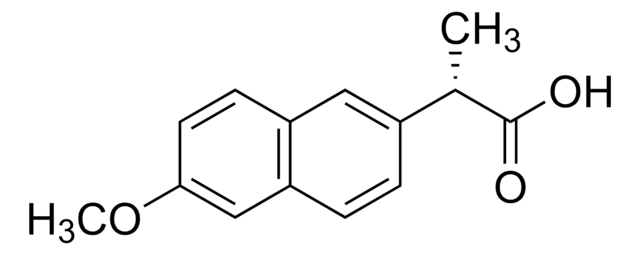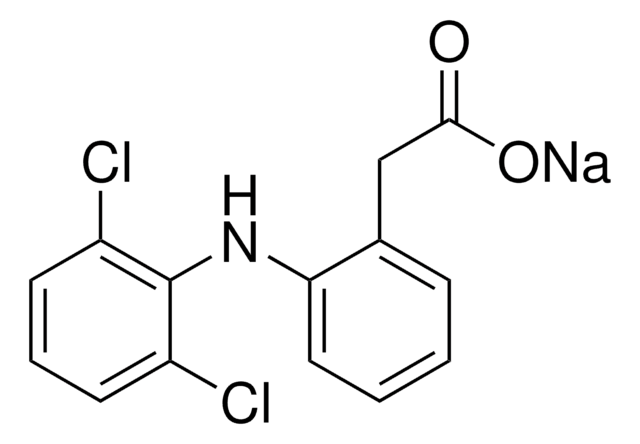I4883
Ibuprofen
≥98% (GC), powder, COX inhibitor
Sinónimos:
2-(4-Isobutylphenyl)propanoic acid, Brufen, Motrin, Rebugen, α-Methyl-4-(isobutyl)phenylacetic acid, (±)-2-(4-Isobutylphenyl)propanoic acid
About This Item
Productos recomendados
product name
Ibuprofen, ≥98% (GC)
origen biológico
synthetic (organic)
Nivel de calidad
Análisis
≥98% (GC)
formulario
powder
mp
77-78 °C
solubilidad
ethanol: 50 mg/mL, clear, colorless to faintly yellow
cadena SMILES
CC(C)Cc1ccc(cc1)C(C)C(O)=O
InChI
1S/C13H18O2/c1-9(2)8-11-4-6-12(7-5-11)10(3)13(14)15/h4-7,9-10H,8H2,1-3H3,(H,14,15)
Clave InChI
HEFNNWSXXWATRW-UHFFFAOYSA-N
Información sobre el gen
human ... ALB(213) , ALOX5(240) , CYP1A2(1544) , CYP2C9(1559) , IL8RA(3577) , PTGS1(5742) , PTGS2(5743)
mouse ... Alox5(11689)
rat ... Alox5(25290) , Ptgs1(24693)
¿Está buscando productos similares? Visita Guía de comparación de productos
Descripción general
Aplicación
- to study its vascular and pulmonary effects on neonatal lung development
- to study its effects on cell apoptosis, cell proliferation, and histology changes in human cholangiocarcinoma cell lines
- in the preparation of a terpene-based therapeutic deep eutectic system (THEDES) to investigate its physicochemical, antimicrobial, and anticancer properties
Acciones bioquímicas o fisiológicas
Aplicación
Palabra de señalización
Warning
Frases de peligro
Consejos de prudencia
Clasificaciones de peligro
Acute Tox. 4 Oral - Eye Irrit. 2 - STOT SE 3
Órganos de actuación
Respiratory system
Código de clase de almacenamiento
11 - Combustible Solids
Clase de riesgo para el agua (WGK)
WGK 1
Punto de inflamabilidad (°F)
Not applicable
Punto de inflamabilidad (°C)
Not applicable
Equipo de protección personal
dust mask type N95 (US), Eyeshields, Gloves
Certificados de análisis (COA)
Busque Certificados de análisis (COA) introduciendo el número de lote del producto. Los números de lote se encuentran en la etiqueta del producto después de las palabras «Lot» o «Batch»
¿Ya tiene este producto?
Encuentre la documentación para los productos que ha comprado recientemente en la Biblioteca de documentos.
Los clientes también vieron
Nuestro equipo de científicos tiene experiencia en todas las áreas de investigación: Ciencias de la vida, Ciencia de los materiales, Síntesis química, Cromatografía, Analítica y muchas otras.
Póngase en contacto con el Servicio técnico










